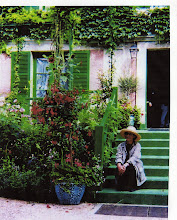
These are the "bullet" point sheets we will give you May 9 - basics we will cover in the demonstration.
Raised Bed construction:
Preparing the site/considerations
Is the site level?
Is the site an existing garden space or will it be constructed on a lawn area?
Amount of sunlight and irrigation
Existing garden space: Level approximate area and set frame level with stakes installed every 4' inside of the frame. Loosen soil with in frame with a garden fork and or shovel. Fill bottom with 2-4" of well rotted compost, cover with a layer of cardboard or 3-6 sheets wet newspaper and fill remaining 8" or so with composted garden soil, fertilizers, leaf mold.
Lawn area: Cut turf out within the dimensions of the frame with a metal edger and shovel saving the sod. Break up the soil with a garden fork or shovel and level area with a rake. Set frame level using stakes installed every 4' inside of frame. Lay sod upside down inside frame and cover with cardboard or wet newspaper. Fill remaining *" or so with your garden soil.
Construction:
Materials ( for a 4' x 12' raised bed)
- (2) 12', 2x10
- (2) 3'9" , 2x10
- (4) 18" - 24" corner braces with a 45 degree angle cut on ends
- (1) 3'9" 2x4 mid-support
- 3 1/2 " nails or screws - galvanized or stainless
- (4-6) 2-3' 2x4 stakes
Description:
- Nail together frame "upside down" next to prepared site.
- Square frame using 3' 4' 5' triangle method, or by measuring diagonally both ways making sure to have even measurements.
- Attach corner braces when frame is square
- Install mid-support at center
- Flip the frame over into prepared soil and level by driving stakes every 4' inside and attaching to frame using nails or screws.
- Fill the frame as described above, plan your garden, and Happy Planting!
Questions? - Ask for Dane at Seaside Gardens Inc. - 165 Hummock Pond Road or call: 508-228-1732
Square Foot Gardening:
Planning
– Grow only what you will use
– Draw a map and use it (don’t forget to save it for next year)
– Rely on succession planting to extend the growing season
– Practice crop rotation
Benefits of Raised Bed Gardening
– Better production per square foot
– Easy to amend and fortify soil
– Advantageous for water conservation
– Easier on the back
– Less difficult to control pests
– Warms up faster so seeds and seedlings can be started earlier
Basic Rules of Square Foot Gardening
– Don’t walk on the growing soil. (easier to accomplish with a raised bed)
– Keep replanting each square as it is harvested.
– Cover newly planted seeds and seedlings to protect them.
– Water with sun warmed water.
– Add humus (organic matter) to the soil every time you plant a crop.
– Plant only 1-2 seeds in their final spacing.
– Use spacing rules for 12” square
Spacing and Planting
– One plant per 12” grid
· Vine tomatoes, broccoli, cabbage, cauliflower, corn, eggplant, musk melon, peppers
– Four plants per 12” grid
· Swiss chard, leaf lettuce, parsley
– Nine plants per 12” grid
· Bush beans, spinach
– Sixteen plants per 12” grid
· Beets, radishes, carrots, onions
Reference Material
Bartholomew, Mel. Square Foot Gardening. The Rodale Press, 2005.
www.squarefootgardening.com
And another from Natalie who will be demonstrating Square Foot planting techniques May 9
Square Foot Gardening Bullet Points
1. What Is the square foot method?
-squares Instead of rows
- plant only what you desire to harvest
- reduce material and water waste
- reduce maintenance ie. weeding, thinning etc
2. Climbing/ VinIng plants
-vertical structures
- space saving and easier on the back to harvest
3. Companion planting
- pest deterrent crops ie. onions, garlic, marigolds and nasturtiums
plated In alternating squares.
- legumes In the garden and as cover crops such as red clover
NITROGEN FIXING
4. Crop rotation
- prevent nutrient deficiency
- prevent pest attraction
5. Succession Planting (kind of like companion planting but different
because It deals with timing)
-always have a continuous harvest-- don't get stuck with 56 carrots
all at the same time!
- quick maturing vs long season crops (Inter sowing In the same
space) ie. radishes and carrots or arugula and peppers
6. Planting
for this I will show how to direct sow and also how to transplant
seedlings I will also go through the logistics of buying,storing and
planting: seed potatoes, onion sets and garlic cloves
- placement of full sun and partial sun vegetables
7. Harvest
Don't treat your soil like dirt!
This is part of the "bullet points" for soils - in general, but specifically for the raised beds workshops. - from Natalie
Soil filling/ mixing bullet points:
Importance of healthy soil:
-high organic matter
-high rate of microorganisms and bacteria
-how synthetic fertilizers and excessive and unnecessary
pesticides/fungicides will set soil health back
2. Soil Structure-
-sand, silt and clay plus at least 8%-12% Organic matter
-drainage
-how soil should feel In the hand/ the clumping test
3. Amendments for sandy Nantucket soil
-peat moss/ vermiculite
-green sand
-compost
-well rotted manure
-leaf mold
-humus and how It works (don't worry I wont go Into cationic exchange
capacity)
-Importance of earthworms!
4. Fertilizers
I don't really use fertilizers often I rely on healthy soils
-organic vs. synthetic
-slow release vs quick release
DON'T FEED THE PLANT FEED THE SOIL
5. PH
-Importance of PH being right for the plant
-plant cannot access nutrients unless PH Is right
- Nantucket PH, soil tests and amendments like lime and wood as

No comments:
Post a Comment